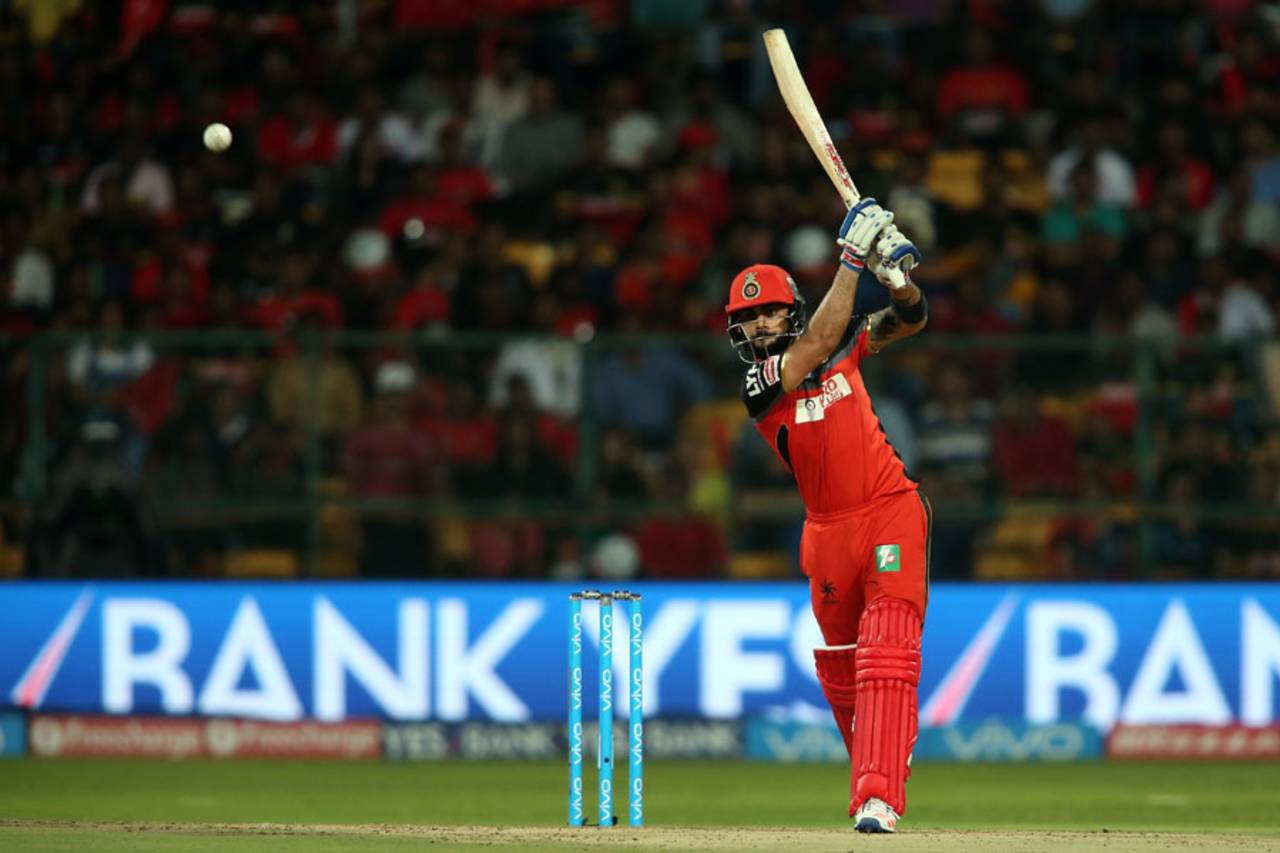There was one thing
Virat Kohli failed at on Wednesday night: trying to restrain his grin as he walked off with a century
in a 15-over match. He bit his lip. That didn't help. He bowed his head. But that only made him look cooler.
There was a time when Kohli simply seemed agitated playing Twenty20 cricket. He wasn't always as strong as he is now. He couldn't thwack sixes as often as he does now. It had bred frustration, which clouded his mind and reduced him to base instinct. For a bottom-handed player such as him, that roughly means slogging into the leg side. Until December 2015, he averaged 35.37 with a strike-rate of 128.97. No centuries. Thirty-two fifties.
Kohli's first boundary on Wednesday came off the first ball he faced, standing tall to dispatch a back of a length delivery through the covers. A shot like that depends on the top hand for timing and direction, so bottom-handed players have trouble getting the maximum out of them. The same holds true for inside-out drives through the off side.
But Kohli is a master of those, against pace and spin. He has become so adept that he can pierce any gap from point to mid-off and this evolution has contributed to some insane numbers. Since January 2016, his average is 99.33 and his strike-rate 148.11. Four centuries. Twelve fifties. That is half as many 50-plus scores in one year as he had made in the previous eight.
Kohli was always a monster on the leg side with the power he generates with his wrists. Now he is a phenom on the off side as well.
You have to put yourself in the bowler's shoes to understand the impact of that. You think you can be safe with a nice, fifth or sixth stump line, but he can carve it to third man, drill it through the covers or thump it back over your head. Okay, target the stumps then. But the bottom-handed meanie will whip it anywhere between square leg and mid-on. Is it any wonder that Kohli has hit 443 runs on the off side and 422 on the leg side in this IPL?
A bottom-handed player being more productive on the off side is a sign he has broken his limitations. Kohli has done so by developing a shot that could eclipse his flick and become his new trademark, at least in one-day cricket, when there is considerably lesser swing and seam movement. The cover drive.
It was the first thing he practiced when he got to the middle - off the front foot and the back foot - and it brought him the first of his eight sixes against King XI Punjab when he charged at KC Cariappa and hit with the legspin. He can play it from the crease, or outside it, on the up and any which way he pleases. Kohli's strike-rate through the covers in this IPL is 156.20. In all T20s prior to the start of the season, that figure had been wallowing at a mere 118. Party to this improvement is his knowledge of when to use the shot.
"Your head should always be where your toe is, that's how your body is dictated when you're playing the drive," Kohli demonstrated in a batting masterclass for iplt20.com in April. "And that's how you connect [with] the ball close to your body, close to your head and it stays in control.
"If the ball pitches ahead of [where] your foot [can reach], you have to play it along with your pad and make sure your follow through is such that the ball bounces right in front of you. If the ball is a bit fuller, the sensible thing to do, which I do most often, is I collapse my back foot rather than bending on the front foot."
So many factors at play. So many decisions to make. And all Kohli gets is a split second. In addition to that, a bottom-handed player has to let go of his natural inclinations to play the drive well. Otherwise, he might hold the bat too tightly, the wrists lock up and a full flow of the arms is not easy.
Creditably, Kohli hasn't been pushed into overhauling his technique to expand his range. He has adjusted by moving his feet and himself into a position - usually quite a distance outside leg - where the bottom hand does all the work to get the cover drive away. There have been times when he has nailed the shot without making room too. Remember the fours he shovelled through the off side against West Indies and Australia in the World T20? The wristy flourishes at the end are a clear indication of his bottom-hand dominance.
So Kohli, it appears, hasn't abandoned his natural game. He has merely augmented it in the quest to become a complete batsman.
Victory may not be that far off.
Stats provided by Shiva Jayaraman and Bharath Seervi
Alagappan Muthu is a sub-editor at ESPNcricinfo
